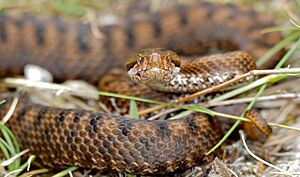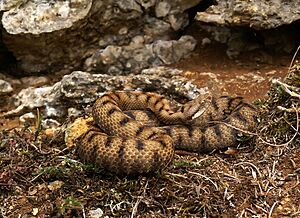Vipera aspis facts for kids
Quick facts for kids Vipera aspis |
|
|---|---|
 |
|
| Conservation status | |
| Scientific classification | |
| Genus: |
Vipera
|
| Species: |
aspis
|
| Synonyms | |
|
|
The Vipera aspis is a type of viper snake found in southwestern Europe. It is also known by names like asp, asp viper, or European asp. Like all vipers, it is a venomous snake. Its bite can be quite painful. About 4% of untreated bites can be very serious. The name aspis comes from a Greek word meaning "viper." There are five different types, or subspecies, of this snake.
Contents
About the Asp Viper
What Does It Look Like?
The Asp Viper usually grows to be about 60 to 65 centimeters (about 2 feet) long. Male snakes can reach up to 85 cm, while females are usually a bit shorter, around 75 cm. Males are often a little thinner than females. Their tail is quite short.
The head of the Asp Viper is wide and shaped like a triangle. It stands out clearly from its neck. The tip of its nose points slightly upwards. The patterns on its back can be very different from one snake to another. They usually don't have the clear zigzag pattern you might see on other vipers like the European adder.
Common Names and History
Common names for Vipera aspis include "asp," "asp viper," "European asp," and "Jura viper." In the past, the word "asp" was used for many different kinds of venomous snakes.
You might have heard stories about the Egyptian Queen Cleopatra and a snake. Some old writings say she was bitten by an asp. However, experts today think it might have been a cobra. A cobra would have been too big to hide easily, so it's a bit of a mystery!
Where Asp Vipers Live
Asp Vipers live in several countries in Europe. You can find them in France, Andorra, parts of northeastern Spain, and a small area in southern Germany. They also live in Switzerland, Italy, and northwestern Slovenia.
Long ago, they were also found in Bulgaria, but they are not there anymore. In 2006, some Asp Vipers were found in the Netherlands. They were doing well, but they are not native to that country. It's thought that these snakes either escaped or were set free by people.
Where They Like to Live (Habitat)

Asp Vipers like warm, sunny places. They prefer areas with plants and dry soil. In Italy and France, they often live in low mountains or hills, especially in limestone areas. They like places with some cover, like sunny slopes, bushy areas, forest clearings, or the edges of woods. You might even find them in old stone quarries. They can live at high altitudes, sometimes over 2,100 meters (about 6,900 feet) above sea level in the Pyrenees mountains.
Asp Viper Venom
A bite from an Asp Viper can be very painful. The venom can cause swelling and discoloration quickly. Sometimes, severe tissue damage can happen within a few hours. Vision might also be affected. The venom can change how blood clots, sometimes making it clot too much or not enough. It can also affect the kidneys, which can be very serious.
Some people who have been bitten by this snake have shown signs of nerve problems, like trouble breathing or swallowing, and even weakness in the bitten limb.
Types of Asp Vipers (Subspecies)
There are different kinds of Asp Vipers, each with its own special name and living area.
| Subspecies | Common name | Where it lives |
|---|---|---|
| V. aspis aspis | European asp | Most of France, northwestern Italy, and western Switzerland. Also found in parts of Spain and a small area of southern Germany. |
| V. aspis atra | Black asp | Parts of Switzerland, and the French and Italian Alps. |
| V. aspis francisciredi | Central Italian asp | Central Italy. |
| V. aspis hugyi | Southern Italian asp | The south of Italy. |
| V. aspis zinnikeri | Gascony asp | Gascony in France, Andorra, and nearby Spain. |
Conservation Status
The Asp Viper is currently listed as "Least Concern" by the IUCN Red List. This means that, overall, its population is stable and it's not in immediate danger of disappearing. It lives in many places and can adapt to different habitats.
However, some specific types of Asp Vipers are more at risk. For example, the V. a. aspis subspecies is "Critically Endangered" in Switzerland. The V. a. atra is "Vulnerable," and the V. a. francisciredi is "Endangered." This shows that even if a species is doing okay overall, some of its local populations might need special protection. The species is also protected under the Berne Convention.
Images for kids
A Vipera aspis eating a lizard, Tuscany, Italy.







